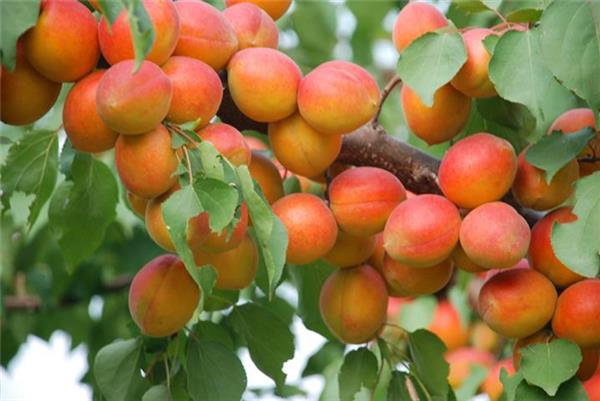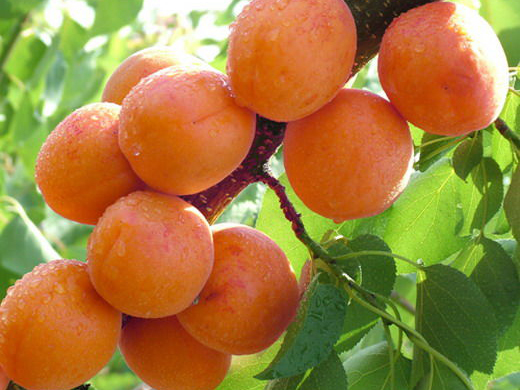[Apricot planting] Detailed explanation of apricot planting technology
Apricot is a kind of fruit that many people like to eat, and the almonds in its kernels have multiple edible values such as making drinks, cooking dishes and serving as snacks. Learn to cultivate apricot trees and then plant them. You can eat pure natural and pollution-free delicious apricots and almonds.

Apricot varieties suitable for planting
L. Golden sun apricot: American variety, the average single fruit weight is 66.9 grams, the largest fruit weight is 87.5 grams, the fruit surface is golden, bright and beautiful, the pulp is free from the core, tender and juicy, good quality, anti-cracking fruit, more resistant to storage, facility cultivation can mature in the middle of April. Strong adaptability and stress resistance, strong self-fruiting and high yield.
2. Wang apricot in greenhouse: its maturity is 5-7 days later than that of Jinyang apricot. It is a new variety of European apricot with an average single fruit weight of more than 125g, a high fruit setting rate of 2OOKO, early and essential excellent, high and stable yield and strong adaptability, which is very suitable for greenhouse cultivation.
3. Kate apricot: the American fruit is nearly round and very large, with an average single fruit weight of 5.5 grams and a maximum of 38 grams. The peel is orange, the sun is red, the flesh is orange, the flesh is fine, the juice is rich, the taste is sour and sweet, the flavor is strong, the quality is high, and the protected cultivation is mature in late April. The variety has strong tree nature, exuberant growth, rapid crown expansion, moderate tree potential in the full fruit period, high yield and stable yield.

II. Matters needing attention in planting apricot trees
Planting: select seedlings with good root system, strong and substantial branches, reaching a certain height and thickness, and no serious diseases and insect pests and mechanical damage. Apricot trees can be planted in spring and autumn. the suitable period for planting apricot trees in spring is from the thawing of soil in early spring to the middle of April, and from defoliation to freezing in autumn.
Fertilizer and water: irrigate at least once before sprouting, after flowering, in autumn and before soil freezing. Irrigation and topdressing can be carried out at the same time. If you encounter a year with a lot of rainfall, you should pay attention to the drainage and waterlogging prevention of apricot orchard. Base fertilizer is given to people before the leaves fall. Topdressing applied human available nitrogen combined with phosphorus and potassium fertilizer before sprouting and fruit expansion period; after fruit picking, topdressing mainly applied phosphorus and potassium fertilizer, a small amount of nitrogen fertilizer; after fruit picking, the combination amount of nitrogen fertilizer could be increased appropriately.
Pruning: young trees are highly dry in shaping and pruning apricot trees, so it is appropriate to adopt the natural happy shape of multiple main branches. Results the pruned apricot trees in the initial stage can blossom and bear fruit 3 years after planting, and the growth potential of branches in this period is still very strong. Its pruning of 0 is to continue to expand the crown, maintain the necessary tree shape, and cultivate as many fruiting branches as possible. The fruiting part moved outward in the middle and later stage of the full fruit stage, and the branches in the lower part of the crown began to be bald, so the main task of pruning in the full fruit period was to adjust the relationship between fruit and growth, keep the tree strong and prolong the full fruit period. In the aging period, the main task of pruning apricot trees is to rejuvenate, renew and re-cultivate fruiting branches. The specific pruning method is to aggravate the retracted and weak perennial branches, stimulate latent buds to sprout vigorous branches, and choose to cultivate new backbone branches, extended branches and fruiting branches.
Harvest: after fruit harvest, apricot trees need to open the corners of young and prosperous branches to ease the tree potential and promote flower formation. The second coring of the new shoots was carried out to promote the branching and cultivate the branch group. Cut off the growing branches, disease and insect branches in time. The branches of diseases and insect pests were centrally burned.

III. Prevention and control of apricot diseases and insect pests
1. Apricot tumor disease: this disease occurs on apricot new shoots, apricot leaves, apricot flowers and fruits. It usually appears after the apricot trees have fallen flowers. The tender shoots of the injured apricot trees grew slowly, began to be dark red, and gradually turned yellow.
Prevention and treatment: find the place of apricot tumour disease, cut off the diseased branches and leaves in time, and burn them centrally, so that it can be controlled basically for 2-3 years.
2. Almond wasp: before fruit ripening, almond bee larvae damage apricot fruit, resulting in early fall of apricot fruit.
Prevention and control methods: timely collection of fallen fruit, deep burial. Spraying 2500 times deltamethrin or killing permethrin around May has a good effect on killing larvae.
3. Apricot fruit weevil: April to June is the period when apricot fruit weevil is easy to occur, which eats apricot buds and buds, lays eggs after falling flowers, and harms apricot fruit.
Control method: can catch insects manually, or spray 200x 50% wettable DDT.

Well, after reading the above introduction, do you have a better understanding of how to plant apricot trees? Apricot trees can not only produce delicious fruit, but also play a role in shade and cool in summer, so it is very suitable for courtyard breeding.
Related
- Wuhan Hospital Iron Tree Blooming Result Was Instantly Frightened by the Gardener Master
- Which variety of camellia is the most fragrant and best? Which one do you like best?
- What is the small blue coat, the breeding methods and matters needing attention of the succulent plant
- Dormancy time and maintenance management of succulent plants during dormancy
- Minas succulent how to raise, Minas succulent plant pictures
- What are the varieties of winter succulent plants
- How to raise succulent plants in twelve rolls? let's take a look at some experience of breeding twelve rolls.
- Attention should be paid to water control for succulent plants during dormant period (winter and summer)
- Watering experience of twelve rolls of succulent plants
- Techniques for fertilizing succulent plants. An article will let you know how to fertilize succulent plants.



